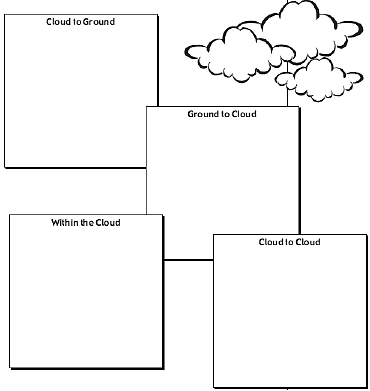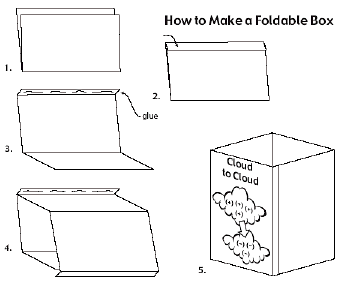Stuck On You
Group Size
Individual
Summary
After completing a K-W-L-H Chart on electricity, students will discuss and illustrate the four ways lightening can move.
Materials
- Two sheets of colored bond paper for each student
- Elmer's glue
- Scissors
Additional Resources
Books
- Hands-on Physical Science Activities, by Marvin N. Tolman; ISBN 0-13-230178-4
- Teaching Science with Foldables, by Dinah Zike (Glencoe McGraw-Hill); Student Edition ISBN 0-07-828238-1, Teacher Classroom Resources ISBN 0-07-828642-5
- Lightening, by Seymour Simon; ISBN 0-590-12122-7
- Thundercake, by Patricia Polacco; ISBN 0-698-11581-3
- Who Was Ben Franklin?, by Dennis Brindell Fradin; ISBN 0-448-42495-9
- Nurturing Inquiry: Real Science for the Elementary Classroom, by Charles R, Pearce (Heinemann); ISBN 0-325-00135-9
Intended Learning Outcomes
1. Use Science Process and Thinking Skills
3. Understand Science Concepts and Principles
4. Communicate Effectively Using Science Language and Reasoning
Instructional Procedures
Attachments
Invitation to Learn
Begin with a riddle.
Clues
- I like to move from place to place.
- When the toaster and TV are on, I am there.
- When the doorbell buzzes, I am there.
- I amaze, delight, and help people every hour, day after day.
- I have a home in various places.
- You can't see or hear me.
- I light up things.
- I am present in thunderstorms.
- Can you guess who I am? If you're right it could be downright shocking to you! (electricity)
 We will be studying electricity for the next few weeks. First, let's
assess what you already know by creating a foldable called a
K-W-L-H chart. It stands for:
We will be studying electricity for the next few weeks. First, let's
assess what you already know by creating a foldable called a
K-W-L-H chart. It stands for:
What you already Know.
What you want to find out.
What you Learned.
How you can learn more.
We will add new information to our chart throughout the unit.
Instructional Procedures
How to Make A Mini Book
- To make a mini book, fold a sheet of paper in a horizontal fold (hamburger fold).
- With the paper horizontal, and the fold of the paper up, fold the bottom edge to the top (hotdog fold).
- With the fold of the paper up, fold in half again (hamburger fold).
- Open the mini book to the first fold, with the folded edge at the bottom. Cut the along the fold half-way to the top of the paper.
- Open and refold as shown, making a book!

- Write K on the first tab, W on the second, L on the third, and H on the fourth. Have students list what they know about electricity under the K tab. Then list what they would like to know under the W tab. This book should be used throughout the unit to assess what students have learned and what they would still like to know.
- Teacher may appear dressed as Ben Franklin, complete with wig, spectacles, jacket, and a kite in one hand. Read pp. 3-10 in Who Was Ben Franklin? Share pictures that show life with and without electricity.
- Lightening is a giant spark of static electricity that forms in the
clouds. Clouds can be made up of ice crystals (light) and water
droplets (heavy). Ice crystals have a positive charge; each water
droplet has a negative charge. During a thunderstorm, negative
charges move from the cloud to the ground and positive charges move from the ground to the cloud. These moving charges are
called lightening. Lightening can also move within a cloud, or
from one cloud to another.

- Draw and label the four ways lightening can move. Make a
foldable box (see below) to illustrate this principle. Include the
charges. Use the titles as headings for each of the four sides of
the box. Draw and label the clouds under each heading, include
the charges.

Extensions
Attachments
- Construct a timeline of electrical discoveries.
- Assign a biographical report on Thomas Edison, Ben Franklin, Guglielmo Marconi, Andre-Marie Amphere, Nikola Tesla, Alessandro Volta, James Watt, Michael Faraday, or Georg Simon Ohm. Write about the individual's life and experiments with electricity.
- Host a biography party where students dress as their inventor and make a mini replica or bring a picture of their invention.
- Create trading cards of their inventor.
- List the three ways to know that static electricity is present:
- A crackling sound may be heard.
- A spark can be seen and can shock you.
- Items cling together with static cling
- Brainstorm a list of everyday occurrences in which static electricity is present.
- Students may write a newspaper article on the lightening storm that hit your town last night using the News Article Frame as a graphic organizer.
- Create a class newspaper using the inventor biographies or newspaper articles.
Family Connections
Read Thundercake as a family on a day that thunder and
lightening storms could happen. Make the cake and serve. While
eating, count between the thunder and lightening bursts to see
how close the lightening is.
Assessment Plan
- Make a Discovery Box to extend inquiry on questions about electricity. Include items that would make exploration of electricity possible. Include a list of Inventor--Testable Questions for investigation.
- Using the Problem/Solution Outline or Discovery Log, have each group write a testable question to research. Go through the steps of the scientific method and come up with a conclusion. Record the investigation in a science journal.
Updated: 10/10/2022


 UTAH EDUCATION NETWORK
UTAH EDUCATION NETWORK

 Justin
Justin Braxton
Braxton Dani
Dani Kayla
Kayla Katie
Katie Matthew
Matthew Rob
Rob Val
Val
